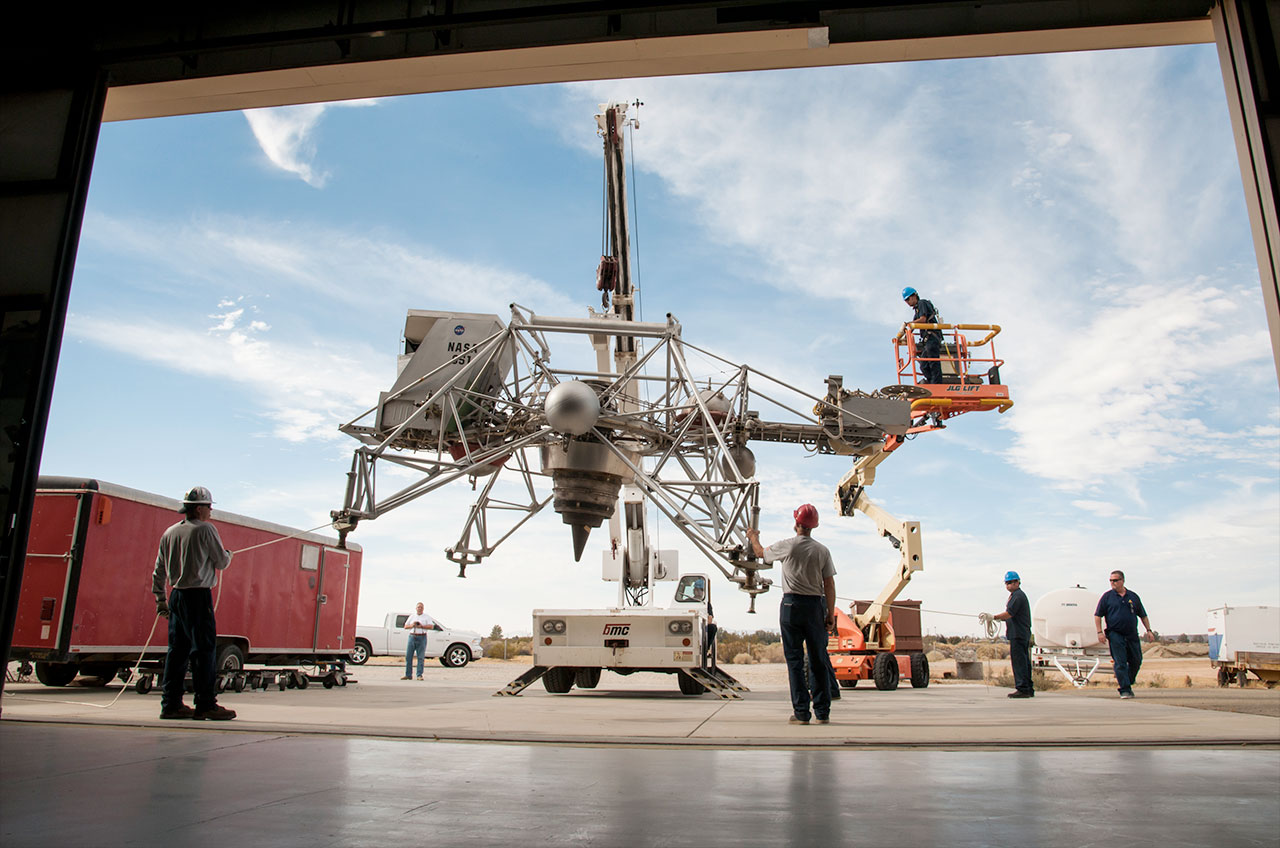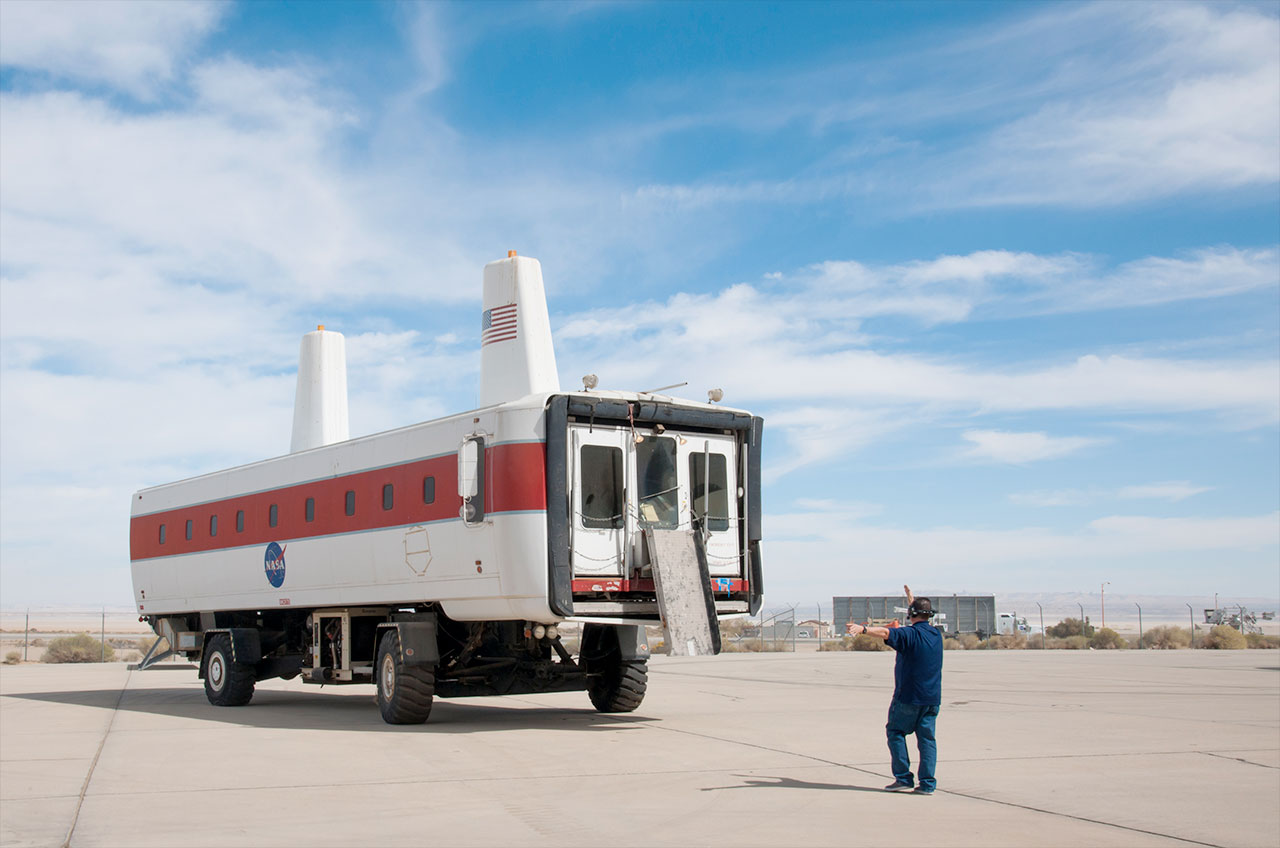NASA Loans Lunar Landing 'Flying Bedstead', Shuttle Transport for Display

Two NASA artifacts that were used to help astronauts who were landing from space, albeit on two different worlds in two different eras, have themselves landed at a museum near where they were last used.
A Lunar Landing Research Vehicle (LLRV) that was used to practice lunar landings for NASA's Apollo program in the 1960s and a Crew Transport Vehicle (CTV) used to move astronauts from space shuttle orbiters after they landed in California in the 1990s have been loaned by the Armstrong Flight Research Center to the nearby Air Force Flight Test Museum on Edwards Air Force Base.
The LLRV, which because of the way it looks, gave way to its nickname, the "Flying Bedstead," was a test craft flown by pilots to develop the techniques for vertical takeoffs and landings on the moon. The second of two LLRVs built, the Armstrong example first went into service at the California center on Oct. 30, 1964. [NASA's 17 Apollo Missions in Pictures]
The aluminum-alloy-framed LLRV was constructed around a central vertical jet engine that stood in for an Apollo lunar module's descent engine. The testbed at first incorporated an ejection seat and rocket-powered control thrusters.
The controls and cockpit configuration were then modified to match three Lunar Landing Training Vehicles (LLTVs), a newer vehicle that integrated the design changes enabled by LLRV flight data. By the Apollo program's conclusion in 1972, one LLRV and two LLTVs had crashed, leaving the Armstrong center's LLRV as the sole survivor of its type.
The late Apollo 11 astronaut, Neil Armstrong, the center's namesake since 2014, famously had to eject from the first LLRV on May 6, 1968 due to a control problem. The crash marked the last flight of an LLRV, in part because the LLTV was soon to enter service.

The sole surviving late-model LLTV is displayed at NASA's Johnson Space Center in Houston.
Get the Space.com Newsletter
Breaking space news, the latest updates on rocket launches, skywatching events and more!
NASA used the space shuttle program-era CTV to transfer astronaut crews from on board the orbiters to Armstrong's (then Dryden's) medical facilities after the shuttles touched down at Edwards Air Force Base.
Flight surgeons performed basic medical examinations on astronauts inside the CTV. The vehicle, acquired in 1990, is a former people mover from Dulles International Airport in northern Virginia. The mover's interior was modified for it to support its role as a mobile medical facility.
A similar CTV, used at NASA's Kennedy Space Center in Florida, was transferred to the Wings of Dreams Museum at the Keystone Heights Airport in Starke, Florida, in 2013.
The Air Force Flight Test Museum in California, is free and open Tuesday through Friday for people with access to the Edwards Air Force Base, including visitors on public tours offered monthly. In addition to Armstrong's LLRV and CTV, which arrived at the museum Oct. 13, the facility exhibits a NASA M2-F1 "Flying Bathtub" lifting body and an SR-71A Blackbird high-altitude aircraft.
Follow collectSPACE.com or Facebook and on Twitter at @collectSPACE. Copyright 2016 collectSPACE.com. All rights reserved.
Join our Space Forums to keep talking space on the latest missions, night sky and more! And if you have a news tip, correction or comment, let us know at: community@space.com.

Robert Pearlman is a space historian, journalist and the founder and editor of collectSPACE.com, a daily news publication and community devoted to space history with a particular focus on how and where space exploration intersects with pop culture. Pearlman is also a contributing writer for Space.com and co-author of "Space Stations: The Art, Science, and Reality of Working in Space” published by Smithsonian Books in 2018.In 2009, he was inducted into the U.S. Space Camp Hall of Fame in Huntsville, Alabama. In 2021, he was honored by the American Astronautical Society with the Ordway Award for Sustained Excellence in Spaceflight History. In 2023, the National Space Club Florida Committee recognized Pearlman with the Kolcum News and Communications Award for excellence in telling the space story along the Space Coast and throughout the world.










